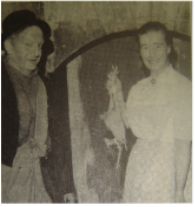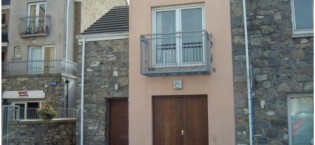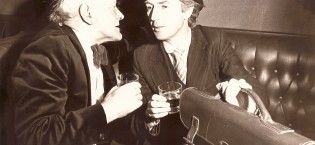“I Remember When The Audience Brought Their Own Hot Water Bottles”
 Hard to imagine a tie without television and very little radio. No pub culture, no nightclubs, no custom-built theatre. What did folk do for a bit of diversion? Apparently, very many of them queued for seats in the makeshift theatres of the Town Hall or Gillooly Hall whenever there was a play on offer, which was never more than a handful of times each year, and there they would be royally entertained by such as the Sligo Unknown Players, the Bernadette Players, and, laterally, the Sligo Drama Circle.
Hard to imagine a tie without television and very little radio. No pub culture, no nightclubs, no custom-built theatre. What did folk do for a bit of diversion? Apparently, very many of them queued for seats in the makeshift theatres of the Town Hall or Gillooly Hall whenever there was a play on offer, which was never more than a handful of times each year, and there they would be royally entertained by such as the Sligo Unknown Players, the Bernadette Players, and, laterally, the Sligo Drama Circle.
This was the heyday of amateur drama, the 1940’s and ’50s, and a leading light in the local drama movement was Kay Guinane, who starred in dozens of productions for all three drama groups of the time, and who is rightly regarded as one of “Sligo’s finest”. Actually, she’s a Limerick woman, but since she’s been almost fifty years in Sligo she’s well entitled to the status of “local”. She came to Sligo in 1944, when her late husband, Jim, took up a teaching appointment at Summerhill College. She had been acting since her school days, so her introduction to the Sligo drama movement was inevitable. “If the whisper got around that anyone new in town could do a bit of singing or acting they would be roped in”, she recalls. “In my own case, I was introduced by a friend to the late Joe Mc Morrow, who invited me to join the Unknown Players. “I can tell you, that was a bit of an honour in itself, because the Unknown Players had a great reputation. I had heard of them long before I ever came to Sligo, so it was marvellous to get the chance to join”
Her first part was as the Reverend Mother in “The Righteous Are Bold”, produced and directed by the company’s mainstays, Margaret and Charlie Hughes, in the Gillooly Hall, and she must have impressed, for she was to become a permanent name in the cast lists thereafter. She recalls that plays in those days, which would normally be put on for four nights at a time, attracted massive audiences, despite the sparse facilities. “It was so cold in some of the halls that I remember people in the audience bringing in their own hot water bottles, and we would often be frozen up on the stage, but it was all great fun”, says Kay. One funny incident stands out. “We brought a play to a festival in Enniskillen during the War years and it was the first time I had ever crossed the border. Being war-time, the people in Enniskillen had virtually nothing because of the food rationing, but a male member of our cast made that work to his advantage. He strapped two pounds of butter to each leg under his trousers, and when we got to the hall he patted the butter back into shape and auctioned it off. I couldn’t believe this was happening, but there was yer man making a right few bob”.
She recalls another occasion when a “love scene” – which actually constituted no more than a harmless peck on the cheek – had to be dropped from a play being performed to an audience of boarders at the Ursuline Convent – because it was Lent! Censorship of that nature was not at all unusual, apparently, as the use of the word “whore” in another production got the protagonists into all sorts of bother. “We were castigated in the Diocesan newspaper “The Angelus”, and people were warned that they would be irresponsible to go and see the play, “Is the Priest at Home”. One priest actually demanded the admission price of 3/6d back. As is the case even today, such publicity had the opposite effect to that intended, and we had a great box-office success”, she recalls.
Another outstanding memory was her participation in the first television outside broadcast transmission from Sligo, in which Mrs. Gay Byrne, Kathleen Watkins, was top of the bill. The programme was “shot” at Lisadell House in 1963 and was presented by Ciarán Mac Mathúna. “Seamus Maguire, aged 12, played a backing on his violin to my rendition of “The Ballad of Moll Magee”. There was lots of Irish music and dancing, and fierce excitement, Naturally, we were all very nervous, but Kathleen Watkins was a great help to us, and it went off very well”, she recalls.She had been auditioned for the show by Joe Linnane, Pam Collins and Bill Skinner, and she must have impressed, for she was to appear in three other shows from the RTE studios at Montrose.
Although she won numerous awards on the festival circuit and for character sketches at the local Fesieanna, Kay never had a hankering to become a full-time actress. “It was never more than a hobby, although it took up a lot of time. But the idea of doing it full time was never really considered. It’s a bit of a dodgy profession”, she maintains. She’s full of admiration for the present crop of local talent, but is naturally reluctant to offer comparisons between the current generation and her own. “I think production generally is a bit too technical these days. I think perhaps there was a bit more instinct and initiative in our day, but that’s not to say that the talent today is any less obvious. I believe there is tremendous talent in Sligo, and long may it continue”, she says.
However generous her appreciation of today’s stage folk, there is a special sparkle in her voice when she recalls some of the people she worked with over the last half century. Names like Dan Mc Cormack, Walter Mc Donagh, Eddie Mc Dermottroe, Eddie Fitzpatrick, Tom and John Mullaney, Padraig Foran, Joe Mc Morrow, Gretta Dunleavy, Pearse Devins, Mary Watson, Tom Palmer, Joe Burns, Eithne Dolan, Paddy Dooney, Joan Fitzpatrick, Mary Mc Govern et al come tripping off the tongue. She also points out that Sligo has made an outstanding contribution to national and international theatre. Joan O’ Hara, Aileen Harte, Pauline Flanagan, Paddy Dooney, Maria Mc Dermottroe and Brendan Cauldwell were all Sligo Unknown Players. She clearly regrets the passing of the Unknown Players. “I was sorry that the name had to go. The groups that came after were all very good, but I thought it was a shame to let the name die. The Unknown Players were synonymous with Sligo drama, and it would have been fitting to keep the name going”.
Away from the stage, Kay had a brief flirtation with local politics, breaking the mould by being elected Sligo’s first woman Alderman on Sligo Corporation in the mid-1970’s. She stayed only one term. “It was an eye-opener in a lot of ways. Here I was believing I knew it all, but I was extremely green when it came to local politics, and I wasn’t all that impressed by it. By the time the first term was up, I had seen enough”, she says. She later played a leading role in revitalising the Sligo branch of the Widows’ Association – she has been a widow now for many years. As Secretary of the branch, her brainchild was the Junior Tops of the Town competition, which ran for four years in the early 1980’s, and raised thousands of pounds for local charities as well as introducing young children to the delights of drama.
“Schools from all over the country were required to put on half-hour variety shows, and we had a tremendous response. It was great for the kids, and it raised a few bob for local charities. My one big regret is that the competition was not continued. I firmly believe it would be a huge success if it was revived, and I would love to see that happening. It would take a lot of hard work, it could be done and I am convinced it would be a success”, Kay explained.
Her last appearance on stage was in Sligo Drama Circle’s production of john B. Keane’s “Sive”, three years ago – and that after a seventeen year break. Although she politely refuses to be drawn on the subject, another stage appearance cannot be ruled out. In the meantime, she’s half thinking about a book on her life and times – it would be a worthy read.
Image shows Kay Guinane with Walter Mc Donagh in a scene from “The Pot of Broth”, winners of the Hughes Cup, Feis Shligigh 1969 and also All-Ireland Winners
An interview with Kay Guinane by Jim Gray in The Sligo Champion, Showstopper Series, August 12th, 1994, reproduced as a tribute to her following her death
Tags: History, Press Reports, Reflections






